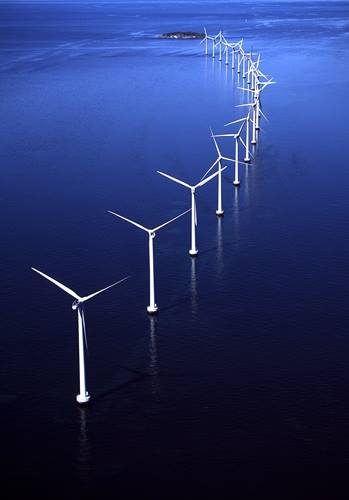Energy & Green Technologies
The Danish government has set an ambitious goal of phasing out fossil fuels by 2050 making Denmark completely independent of fossil fuels. The strategy has clearly defined the first steps towards this ambitious target. From 1980 till 2010 the share of renewable energy in Denmark rose from 3 % to 19 %. With this strategy the rise will continue to 33 % by 2020, meaning a full third of Danish energy will be produced by green energy sources primarily wind and biomass. Nuclear energy is not a part of the strategy of making Denmark fossil free.
This ambitious goal can be reached because Denmark is a global hub for innovation and development within sustainable energy and green technology. More than 30 years ago, Denmark was the first country to install wind turbines, and today on- and offshore wind turbines provide more than 33 per cent of Denmark’s electricity consumption. It is the highest level of wind power integration in the world.
Photo: Wind turbines play an important role in making Denmark fossil free by 2050.
According to recent government targets, Danish wind power will account for 50 per cent of the electricity supply by 2020. The Danish wind industry encompasses more than 350 companies and employs around 25,000 people. As a consequence of the strong Danish competences, one in every three wind turbines and nine out of ten offshore turbines in operation worldwide are based on Danish technology or know-how.
Denmark is not only a world leader in wind power. For decades, Denmark has also utilized biomass to produce energy. Agricultural residue, wood waste and other types of organic waste make up the major part of the biomass used in Denmark complemented by biogas. Today, approximately 70 per cent of renewable-energy consumption in Denmark stems from biomass. In the coming years, Danish consumption of biomass will continue to grow as a source of energy bringing heat and power to both residential and commercial buildings.
As one of the few countries in Europe, Denmark exports excess electricity when domestic production is high and import when production is low since the Danish power grid is integrated with the Swedish, Norwegian and German power grids.
Denmark also ranks as one of the most energy-efficient countries in the EU and the OECD. Many Danish companies have optimized their industrial processes, facilities and equipment and obtained substantial reductions in their consumption of energy, water and packaging. Denmark plans to reduce its final energy consumption by 7 per cent in 2020 compared to 2010. To reach this goal, energy-efficient solutions are widely implemented in newly built and refurbished housing, offices and public institutions all over the country.
To read more about Green Denmark, visit:

